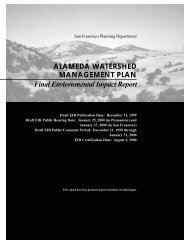Feasibility of Fish Passage at Alameda Creek Diversion Dam
Feasibility of Fish Passage at Alameda Creek Diversion Dam
Feasibility of Fish Passage at Alameda Creek Diversion Dam
Create successful ePaper yourself
Turn your PDF publications into a flip-book with our unique Google optimized e-Paper software.
<strong>Feasibility</strong> <strong>of</strong> <strong>Fish</strong> <strong>Passage</strong> <strong>at</strong> <strong>Alameda</strong> <strong>Creek</strong> <strong>Diversion</strong> <strong>Dam</strong>define the flows under which steelhead are most likely to migr<strong>at</strong>e. Key design requirements for anypassage or screening fe<strong>at</strong>ures would come directly from this analysis.Design components identified th<strong>at</strong> could potentially facilit<strong>at</strong>e adult immigr<strong>at</strong>ion to spawning habit<strong>at</strong>sabove ACDD include:■■■<strong>Fish</strong> ladders<strong>Fish</strong> liftsTrap and haulDesign components to facilit<strong>at</strong>e upstream steelhead migr<strong>at</strong>ion would be oper<strong>at</strong>ional from Decemberthrough April (Table 4-1) (inform<strong>at</strong>ion regarding expected numbers <strong>of</strong> immigr<strong>at</strong>ing steelhead can befound in Section 6.2).<strong>Passage</strong> would also require screening <strong>at</strong> the ACDT, to prevent entrainment <strong>of</strong> fish into the diversiontunnel, and Calaveras Reservoir. Screening in accordance with regul<strong>at</strong>ory criteria would require a fishscreen bypass, which would need to be designed in a manner th<strong>at</strong> could safely provide downstream fishpassage <strong>at</strong> ACDD for both emigr<strong>at</strong>ing juvenile and post-spawn adults. Details on future bypass flows <strong>at</strong>ACDD are presented in Section 2.3.2.2. Bypass flows rel<strong>at</strong>ed to future oper<strong>at</strong>ion <strong>of</strong> CDRP would beprovided <strong>at</strong> ACDD via a new outlet structure proposed as part <strong>of</strong> the CDRP. However, in the analysis inthis memorandum it is assumed th<strong>at</strong> SFPUC-proposed instream flows could also be provided by acombin<strong>at</strong>ion <strong>of</strong> a fish ladder (Section 4.1), and/or a fish screen bypass flow conduit oper<strong>at</strong>ed inconjunction with screening <strong>of</strong> ACDT (Section 4.4). If upstream passage was provided for immigr<strong>at</strong>ingadult steelhead, fish screen bypass flows would be the associ<strong>at</strong>ed primary mechanism allowing emigr<strong>at</strong>ingsteelhead to bypass the dam in a downstream direction.This section describes the adult immigr<strong>at</strong>ion and fish screen design components and provides apreliminary evalu<strong>at</strong>ion <strong>of</strong> their suitability <strong>at</strong> ACDD. Design components th<strong>at</strong> are technically feasible<strong>at</strong> ACDD and th<strong>at</strong> would meet the basic biological needs <strong>of</strong> a steelhead popul<strong>at</strong>ion above ACDD areretained for further evalu<strong>at</strong>ion. Design components are elimin<strong>at</strong>ed from further consider<strong>at</strong>ion in thismemorandum if they serve the same purpose as other design components but <strong>at</strong> a clearly higher cost,with gre<strong>at</strong>er engineering challenges, or are otherwise determined to be less suitable than substitutabledesigns.4.1 FISH LADDERSIn this section, fish ladders (sometimes more generally referred to as fishways) are evalu<strong>at</strong>ed as aspecific design component for providing passage to immigr<strong>at</strong>ing adult steelhead. Following theanalysis, this design component is retained for consider<strong>at</strong>ion l<strong>at</strong>er in this document.A fish ladder is a structure used to facilit<strong>at</strong>e passage <strong>of</strong> fish over or around an obstacle, typically adam or other migr<strong>at</strong>ion barrier (Figure 4-1). Specifically, as defined by NMFS, the fish ladder is thecomponent <strong>of</strong> a fish passage facility th<strong>at</strong> dissip<strong>at</strong>es hydraulic potential energy into discrete pools orinto a baffled chute to provide passage for upstream migrants (NMFS, 2003). <strong>Fish</strong> ladders are themethod most commonly used for allowing upstream fish migr<strong>at</strong>ion past instream barriers. Althoughdesign criteria for fish ladders are primarily based on adult fish immigr<strong>at</strong>ion, when oper<strong>at</strong>ing, somefish ladders also can provide for downstream migr<strong>at</strong>ion.Typically, fish ladders consist <strong>of</strong> a series <strong>of</strong> ascending pools th<strong>at</strong> must be “climbed” or jumped by thefish. A series <strong>of</strong> pools contained within the w<strong>at</strong>er passage acts to incrementally divide the height <strong>of</strong>the passage and to dissip<strong>at</strong>e the energy in the w<strong>at</strong>er, thereby enabling fish to gradually climb theACDD <strong>Passage</strong> June 2009 Page 4-2








